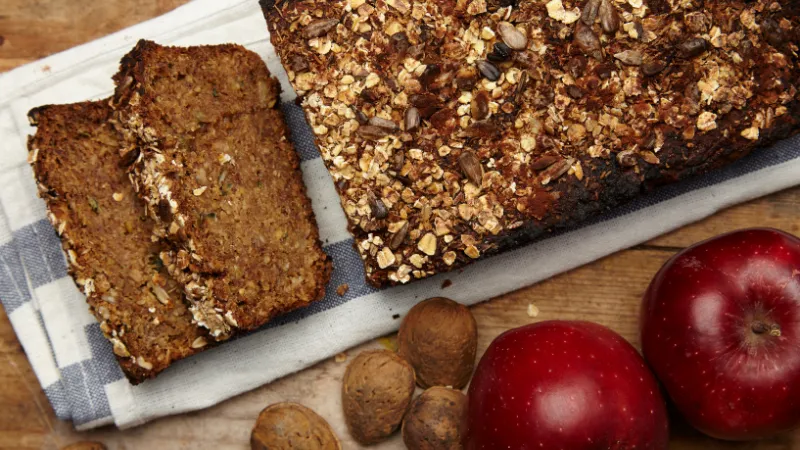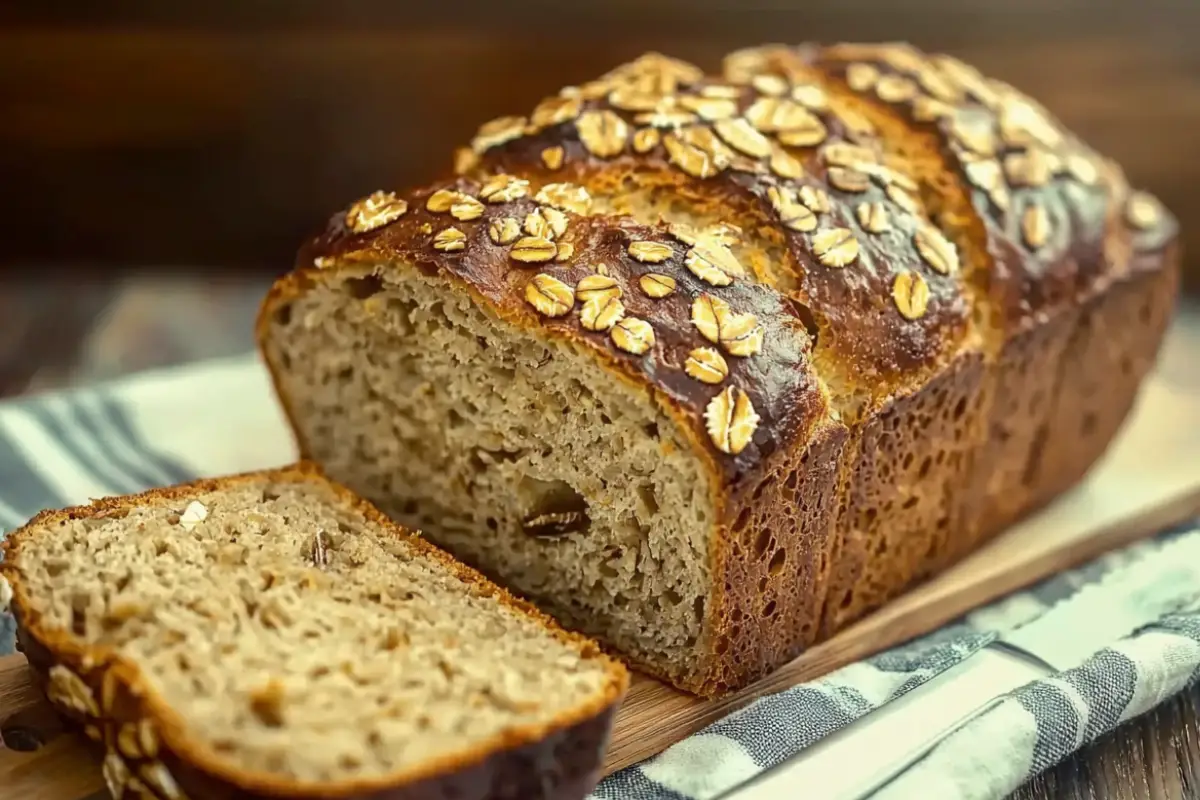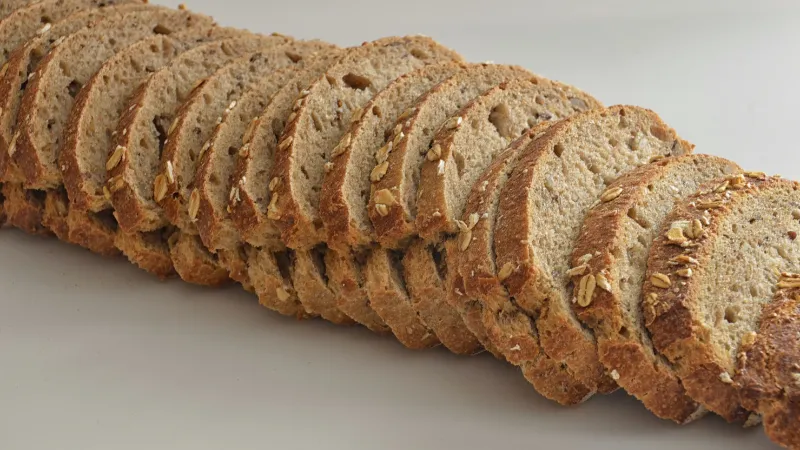Last Updated on May 9, 2025 by Souhail
There’s something deeply comforting about a loaf of oat molasses bread from Maine, it’s rustic, a little sweet, and full of old-fashioned charm. This classic New England recipe combines hearty oats with rich, dark molasses to create a bread that’s both wholesome and delicious. Whether you’re serving it warm with butter at breakfast or alongside a steaming bowl of chowder, it brings a cozy, homemade feel to any meal.
What I love most about this bread is its down-to-earth flavor and simplicity. It’s easy enough for beginner bakers but tastes like something passed down through generations. The oats give it a satisfying texture, while the molasses adds a touch of sweetness and depth. If you’re looking for a loaf that feels like home, especially if home smells like salt air and warm kitchens, this one’s for you.
Table of contents
- Why The Oat Molasses Bread Recipe Works
- Ingredients Breakdown
- Step-by-Step Instructions
- Pro Tips for Success of the Oat Molasses Bread Recipe
- Variants of the Recipe
- Serving Suggestions of Oat Molasses Bread Recipe
- Storage and Reheating Instructions
- Creative Uses for the Recipe
- Recipe Card
- FAQs About Oat Molasses Bread
- Story or Cultural Context
- Final Thoughts
Why The Oat Molasses Bread Recipe Works
1. A Perfect Balance of Flavors
This bread is all about balance. The rich molasses provides a deep sweetness without overpowering the natural nuttiness of the oats. Together, they create a harmonious flavor profile that’s robust and comforting. The bread pairs beautifully with both sweet and savory toppings, making it incredibly versatile.
2. Healthier Than Store-Bought Options
Oat molasses bread brings more to the table than great taste. The oats provide soluble fiber, which is excellent for heart health, while molasses offers trace minerals like iron, calcium, and magnesium. Unlike many commercial breads, this homemade loaf is free from unnecessary additives and preservatives.
3. Traditional Yet Adaptable
This recipe honors the classic Maine preparation but leaves room for customization. Want a dairy-free version? Swap the milk for almond milk. Prefer a nutty crunch? Toss in some chopped walnuts.
4. Beginner-Friendly
Don’t let the idea of bread-making intimidate you. This recipe uses simple techniques and ingredients. The dough is forgiving and easy to work with, even if you’re new to yeast-based baking.
5. A Nod to Maine’s History
Molasses was a staple in early American pantries, especially in New England. Its long shelf life made it a valuable sweetener during harsh winters. This bread celebrates that heritage, offering a slice of history with every bite.
6. Customizable Texture and Shape
You can bake this bread as a rustic round loaf, in a classic bread pan, or even as rolls. Adjusting the shape allows for various serving possibilities, from dinner rolls to sandwich slices.
This oat molasses bread of Maine is more than a recipe; it’s a love letter to Maine’s culinary traditions and a way to bring a bit of New England charm into your home. Ready to dive in? Let’s break it down step by step.
Ingredients Breakdown
For the Dough:
- Oats (1 cup)
Rolled oats work best for their chewiness and texture. Quick oats can be used in a pinch but will yield a softer texture. - Boiling Water (1 ½ cups)
Softens the oats and creates a tender crumb. - Molasses (½ cup)
Use unsulfured molasses for a rich, sweet flavor. Blackstrap molasses is darker and less sweet but can be substituted if you prefer a more robust taste. - Milk (½ cup)
Whole milk gives a rich, tender crumb, but you can use non-dairy milk for a vegan version. - Butter (2 tablespoons, melted)
Adds richness and moisture. Substitute with coconut oil for a dairy-free option. - Salt (1 ½ teaspoons)
Enhances flavor and balances the sweetness of the molasses. - Active Dry Yeast (2 ¼ teaspoons)
Ensures the bread rises beautifully. Instant yeast can be used without proofing. - Bread Flour (4–4 ½ cups)
Provides structure and a slight chew. All-purpose flour works but may result in a slightly softer loaf.
Optional Add-ins:
- Chopped Walnuts or Pecans (½ cup) for a nutty crunch.
- Ground Flaxseed (2 tablespoons) for added fiber and nutrients.
- Cinnamon (1 teaspoon) for a warm, spiced undertone.
Step-by-Step Instructions
Prepare the Oats (5 minutes + cooling time)
- Place the oats in a large mixing bowl.
- Pour the boiling water over the oats, stir, and let them sit for 10–15 minutes. This softens the oats and enhances their texture.
Tip: Use a sturdy, heatproof bowl to avoid cracking when adding hot water.
Activate the Yeast (10 minutes)
- In a small bowl, warm the milk until lukewarm (around 110°F/43°C).
- Add the yeast and a teaspoon of molasses to the milk. Stir gently and let sit for 5–10 minutes, or until foamy. This step ensures your yeast is alive and active.
Tip: If the mixture doesn’t foam, your yeast might be expired, start over with fresh yeast.
Combine Ingredients (5 minutes)
- Add the molasses, melted butter, and salt to the softened oats. Mix well.
- Stir in the yeast mixture until fully incorporated.
Add Flour Gradually (10 minutes)
- Start by adding 3 cups of flour, one cup at a time, mixing with a wooden spoon or a stand mixer fitted with a dough hook.
- Continue adding flour, ¼ cup at a time, until the dough comes together and pulls away from the sides of the bowl.
Tip: The dough should be soft and slightly sticky. Hence, avoid adding too much flour.
Knead the Dough (8–10 minutes)
- Place the dough on a lightly floured surface and knead it until it becomes smooth and elastic. Alternatively, you can use a stand mixer fitted with a dough hook and set it to medium speed.
- Incorporate any optional add-ins, such as nuts or flaxseed, during this step.
First Rise (1 hour)
- Place the dough in a greased bowl, cover with a clean kitchen towel or plastic wrap, and let rise in a warm place for 1 hour, or until doubled in size.
- Test by pressing your finger into the dough, if the indentation remains, it’s ready.
Tip: If your kitchen is cold, place the bowl in a slightly warm (not hot) oven to create an ideal rising environment.
Shape the Dough (5 minutes)
- Punch down the risen dough to release air bubbles.
- Shape it into a loaf and place it in a greased 9×5-inch loaf pan, or shape it into a round and place it on a parchment-lined baking sheet.
Second Rise (30–45 minutes)
- Cover the shaped dough with a towel and let it rise again until it’s about 1 inch above the edge of the pan or doubled in size.
Bake the Bread (30–35 minutes)
- Preheat your oven to 375°F (190°C).
- Bake the bread for 30–35 minutes, or until the top is golden brown and the loaf sounds hollow when tapped on the bottom.
Tip: Use a digital thermometer to ensure doneness. The internal temperature should reach 190°F (88°C).
Cool and Serve (30 minutes)
- Remove the bread from the pan and transfer it to a wire rack to cool completely.
- Slice and serve with butter, jam, or your favorite toppings.
Tip: Letting the bread cool fully helps the crumb set, making slicing easier.
Pro Tips for Success of the Oat Molasses Bread Recipe
- Choose the Right Molasses
Unsulfured molasses is the best choice for a sweet, mild flavor. Avoid blackstrap molasses unless you prefer a more bitter, robust taste. - Hydrate the Oats Properly
Allowing the oats to soak ensures they blend seamlessly into the dough, creating a tender crumb without crunchy bits. - Don’t Skip the Second Rise
This step is crucial for achieving a light, airy loaf. Be patient, it’s worth it! - Adjust for Altitude or Humidity
If you’re baking in a humid environment, use slightly less water to avoid overly sticky dough. At high altitudes, reduce the yeast by 25% to prevent over-rising. - Experiment with Add-ins
This bread is a great canvas for creativity. Try adding dried cranberries, sunflower seeds, or even a sprinkle of sea salt on top for a gourmet twist. - Store Yeast Properly
Keep your yeast in an airtight container in the fridge or freezer to maintain its potency over time. - Use a Kitchen Scale
Measuring your ingredients by weight (especially flour) ensures consistent results. Too much flour can make the bread dense, while too little can make it collapse.
Variants of the Recipe
1. Whole Wheat Oat Molasses Bread Recipe
Substitute half of the bread flour with whole wheat flour to add nuttiness and extra fiber. The whole wheat version is slightly denser but retains the same rich molasses flavor.
2. Gluten-Free Oat Molasses Bread Recipe
Use a gluten-free flour blend and certified gluten-free oats. Add 1 teaspoon of xanthan gum if your blend doesn’t include it. This version works well for those with dietary restrictions while keeping the wholesome flavor intact.
3. Nut and Seed Oat Molasses Bread
Mix in ½ cup of your favorite nuts (walnuts, pecans) and seeds (pumpkin seeds, sunflower seeds) during kneading. This creates a hearty bread packed with texture and nutrition.
4. Spiced Oat Molasses Bread
Add 1 teaspoon of ground cinnamon and ½ teaspoon of ground nutmeg to the dough for a warm, aromatic twist. Perfect for fall or holiday gatherings.
5. Sweet Oat Molasses Bread
Incorporate ½ cup of raisins, dried cranberries, or chopped dates into the dough. This version is excellent for breakfast or tea-time treats.
6. Vegan Oat Molasses Bread
Replace milk with almond or oat milk and butter with coconut oil or vegan margarine. The bread remains moist and flavorful without any animal products.

Serving Suggestions of Oat Molasses Bread Recipe
Oat molasses bread recipe of Maine is a versatile star in your culinary repertoire. Here are some ways to serve and enjoy it:
1. Classic Breakfast Toast
Slice the bread then toast it until golden. Spread with butter, honey, or homemade jam for a satisfying morning treat.
2. Soup Companion
Pair this hearty bread with creamy soups like butternut squash, clam chowder, or split pea. The slight sweetness balances the savory richness of the soup.
3. Sandwich Base
Use the bread for hearty sandwiches, such as turkey and cranberry, ham and cheddar, or a vegetarian combo with hummus, avocado, and sprouts.
4. Gourmet Bread Basket
Serve slices of oat molasses bread with an assortment of spreads, herb butter, olive tapenade, or maple cinnamon cream cheese for a stunning appetizer.
5. Bread Pudding
Day-old oat molasses bread is perfect for bread pudding. Its slightly sweet flavor pairs beautifully with vanilla custard and a drizzle of caramel.
6. Dessert-Style Toast
Top a toasted slice with ricotta, a drizzle of honey, and a sprinkle of cinnamon for a dessert-inspired treat.
7. Charcuterie Pairing
Use this bread as part of a cheese and charcuterie board. It pairs well with sharp cheddar, creamy brie, or tangy goat cheese.
Pro Tip: Serve warm slices for maximum flavor and aroma.
Storage and Reheating Instructions
1. Storing Fresh Bread
- Wrap the cooled loaf in a clean kitchen towel and store it in a bread box for up to 2 days. This keeps the crust slightly crisp while maintaining the bread’s moisture.
- For longer storage, wrap the loaf tightly in plastic wrap or foil and place it in an airtight bag. Store at room temperature for up to 4 days.
2. Freezing the Bread
- Slice the loaf before freezing for convenience. Wrap slices in parchment paper and store them in a freezer-safe bag.
- Frozen bread lasts up to 3 months. When ready to use, thaw slices at room temperature or warm them in the toaster directly from frozen.
3. Reheating Tips
- Oven Reheating: Wrap the loaf in foil and warm in a 350°F (175°C) oven for 10–15 minutes. This restores the bread’s soft texture and fresh-baked aroma.
- Microwave Reheating: Wrap a slice in a damp paper towel and microwave on low power for 10–15 seconds.
4. Avoid Refrigeration
Refrigerating bread can cause it to dry out faster. Stick to room temperature or freezing for the best results.
Creative Uses for the Recipe
1. Stuffing
Transform cubed oat molasses bread into a flavorful stuffing by mixing it with sautéed onions, celery, herbs, and broth. Perfect for holiday feasts.
2. Crostini
Slice the bread thin, brush with olive oil, and toast until crispy. Use as a base for bruschetta or goat cheese spreads.
3. Breakfast Casserole
Layer slices of oat molasses bread with eggs, cheese, and vegetables in a casserole dish. Bake for a hearty breakfast or brunch centerpiece.
4. French Toast
Dip thick slices in a cinnamon-vanilla egg batter and cook until golden brown. Top with maple syrup and fresh fruit.
5. Breadcrumbs
Stale oat molasses bread can be blitzed into breadcrumbs for coating chicken, fish, or vegetables. The molasses adds a subtle sweetness to your dishes.
Recipe Card
FAQs About Oat Molasses Bread
Yes, but it will lose its distinctive flavor. You can substitute honey or maple syrup for a milder sweetness, though the color and taste will differ.
Ensure your yeast is fresh and active by testing it in warm milk or water before mixing. A too-cool environment can also slow rising; try placing the dough in a warm oven (turned off) or near a heat source.
Yes, but the texture will be softer, and you may need slightly less liquid since quick oats absorb water more quickly.
Avoid adding too much flour; the dough should be soft and slightly sticky. Knead thoroughly to develop gluten, which creates an airy texture.
Unsulfured molasses is ideal for its mild sweetness and clean flavor. Blackstrap molasses is darker and less sweet but works if you prefer a stronger taste.
Yes! After the first rise, shape the dough and freeze it in an airtight container. Thaw overnight in the refrigerator, then let it rise again at room temperature before baking.
Story or Cultural Context
Oat molasses bread recipe of Maine is more than just a staple in Maine kitchens; it’s a symbol of New England’s resourceful culinary traditions. During the 18th and 19th centuries, molasses became a household essential in New England due to the booming trade of sugar and molasses from the Caribbean. Its long shelf life and affordability made it a key ingredient in both sweet and savory dishes.
In Maine, where winters can be harsh, molasses provided a rich source of energy and flavor, complementing the local availability of oats. Together, these ingredients formed a nourishing and economical bread that could be enjoyed year-round. Whether served with clam chowder or used for sandwiches packed for a day of lobster fishing, this bread reflects Maine’s deep connection to its land and sea.
Making oat molasses bread today is like stepping back into the kitchens of early settlers, simple ingredients, a little patience, and a lot of love.
Are you ready to bring a bit of Maine into your kitchen? I’d love to hear how your oat molasses bread turns out! Share your results, photos, or any creative twists you added in the comments below. Don’t forget to tag me on social media when you share your baking success—I can’t wait to see your beautiful loaves!
Final Thoughts
Baking this oat molasses bread recipe of Maine is more than creating a delicious loaf, it’s about connecting with tradition and savoring the simplicity of wholesome ingredients. Whether you’re serving it fresh out of the oven, repurposing it into croutons, or pairing it with a hearty soup, this bread is sure to become a staple in your home.
Once you’ve mastered this oat molasses bread recipe of Maine, don’t stop here! Check out other bread recipes like Banana Bread Recipe to keep your baking journey alive. Happy baking!


